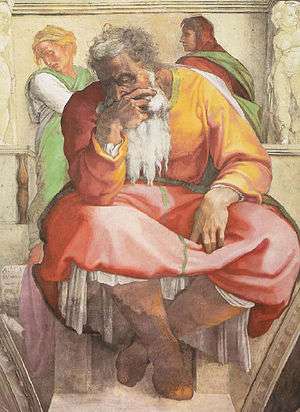Prophet Jeremiah (Michelangelo)
The Prophet Jeremiah is one of the seven Old Testament prophets painted by the Italian High Renaissance master Michelangelo (c. 1510-12) on the Sistine Chapel ceiling. The Sistine Chapel is in Vatican Palace, in the Vatican City.
| The Prophet Jeremiah | |
|---|---|
 | |
| Artist | Michelangelo |
| Year | circa 1508–1512 |
| Type | Fresco |
| Dimensions | 390 cm × 380 cm (150 in × 150 in) |
| Location | Sistine Chapel, Vatican Palace, Vatican City |
This particular fresco is the first one on the left from the side of the High Altar. The person of Jeremiah is imagined as lost in anguished meditation. Although the painting portrays Jeremiah as lamenting over the Destruction of Jerusalem, critics have interpreted the figure as a self-portrait by Michelangelo, with the artist lamenting over the weight of his sins.
Influential English critic Roger Fry used the figure to illustrate his emotional elements of design, or how formal elements such as mass and space produce emotion:
When, for instance, we look at Michelangelo's "Jeremiah," and realise the irresistible momentum his movements would have, we experience powerful sentiments of reverence and awe.[1]
Notes
- Fry, 1920, p. 23.
References
- Fry, Roger. 1920. "Vision and Design." London: Chatto & Windus. "An Essay in Æsthetics." 11–24. Accessed online on 13 March 2012 at https://www.scribd.com/doc/52044301/Roger-Fry-Vision-and-design
